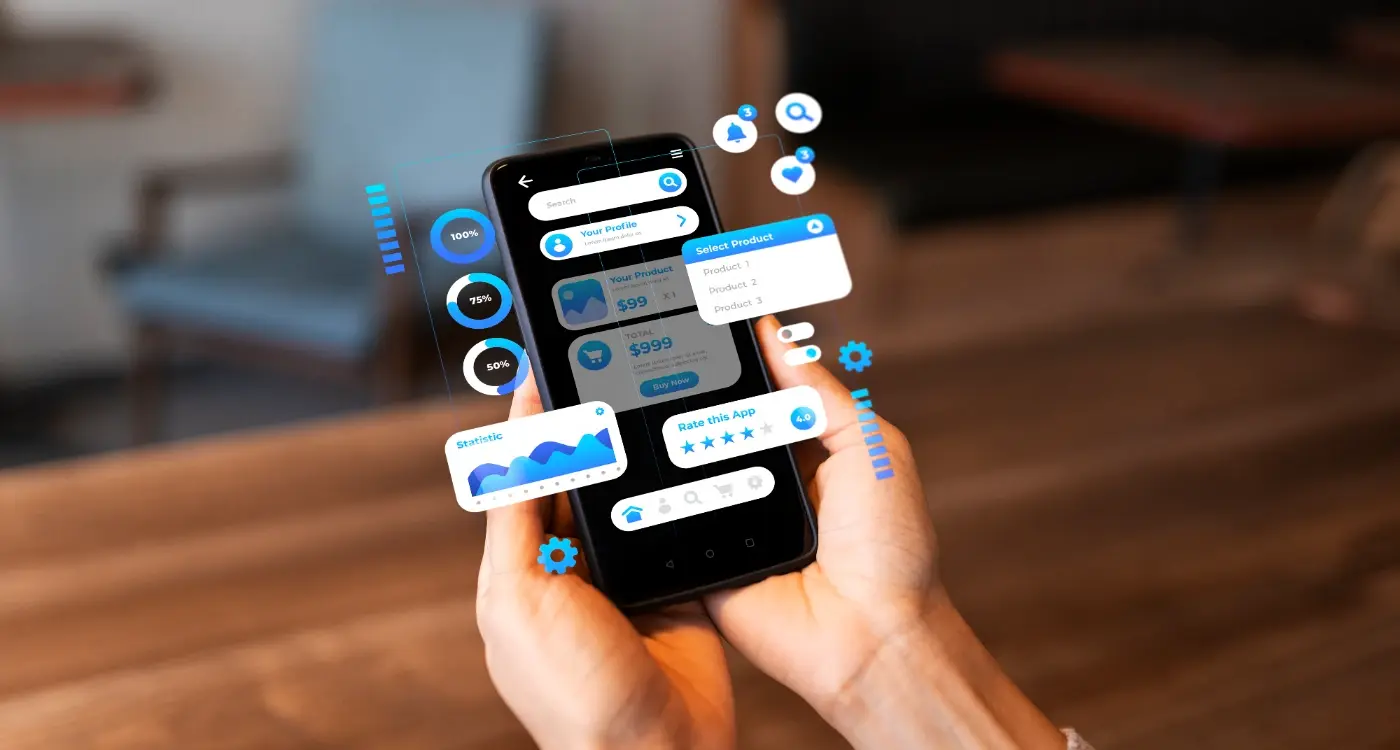What Happens When AI Gets Your App Users Completely Wrong?
Have you ever opened an app and been shown content that makes you wonder if the algorithm thinks you're a completely different person? You're not alone—and it's happening more often than you might think.
After building apps for nearly a decade, I've watched artificial intelligence go from a nice-to-have feature to the backbone of user personalisation. And honestly? It's a bit of a double-edged sword. When AI gets it right, users feel like the app was built just for them. But when it gets it wrong—which happens more than we'd like to admit—the results can be spectacularly bad.
I've seen fitness apps recommend rest days to marathon runners, shopping apps push baby products to teenagers, and news apps serving up content that's completely irrelevant to users interests. These aren't just minor hiccups; they're the kind of AI mistakes that make people delete apps immediately.
The most dangerous assumption in app development is that your AI knows your users better than they know themselves
The thing is, we've become so reliant on machine learning to drive personalisation that we sometimes forget to question whether it's actually working. Users don't care about your sophisticated algorithms or your impressive data models—they care about whether your app understands what they want and when they want it. When your AI consistently gets this wrong, it doesn't matter how technically brilliant your solution is; you've got a user experience problem that will kill your app's success faster than any competitor could.
The Real Cost of AI Getting It Wrong
Here's something that keeps me up—watching brilliant apps crash and burn because their AI made terrible assumptions about users. I've seen it happen more times than I care to count, and the financial damage is always worse than anyone expects.
Let's talk real numbers for a minute. When AI personalisation goes wrong, you're not just losing individual users; you're destroying entire customer segments. I worked with an e-commerce app that lost 40% of its female users in three months because the AI kept showing them products based on outdated gender stereotypes. The algorithm assumed all women wanted fashion and beauty items, completely missing the mark for professional women looking for tech gear or sports equipment.
The domino effect is brutal. Wrong recommendations lead to poor engagement, which tanks your app store rankings, which drives up user acquisition costs. One fintech app I know spent £200,000 extra on marketing just to replace users they'd alienated with inappropriate financial product suggestions.
The Hidden Costs Nobody Talks About
Beyond the obvious revenue loss, AI failures create costs that don't show up on your balance sheet immediately:
- Customer service tickets skyrocket as frustrated users complain about irrelevant content
- Development teams spend months fixing recommendation engines instead of building new features
- Brand reputation suffers when users share screenshots of ridiculous AI suggestions on social media
- Legal risks emerge when AI bias violates discrimination laws or accessibility requirements
The worst part? Most companies don't realise their AI is failing until it's too late. They're looking at aggregate metrics that hide the fact they're systematically alienating specific user groups. By the time negative reviews start flooding in, the damage to user trust is already done—and trust is the hardest thing to rebuild in mobile apps.
When Machine Learning Misreads Your Users
I've seen machine learning go spectacularly wrong more times than I'd like to admit. The worst part? It usually happens when everything looks perfect on paper—your data's clean, your algorithms are running smoothly, and your dashboards show users engaging with personalised content. But then the complaints start rolling in.
Here's what actually happens when AI misreads your users: it creates a feedback loop of wrong assumptions. Let's say your fitness app thinks someone's a hardcore runner because they opened running articles a few times. So it floods them with marathon training plans and protein powder ads. But actually? They were just browsing whilst recovering from an injury, looking for gentle walking routines. Now they feel completely alienated by your app.
The really frustrating bit is that machine learning doubles down on its mistakes. Each time that user ignores the running content, the AI might interpret their behaviour differently—maybe they prefer cycling content instead! So now you're showing bike routes to someone who just wants to walk their dog around the block.
The Context Problem
Machine learning is brilliant at spotting patterns, but it's terrible at understanding context. It sees that users who buy premium subscriptions often check the app at 6am, so it starts sending aggressive upgrade prompts to early birds. What it misses: those premium users check early because they're avoiding distractions, not because they want more notifications.
Always test your AI's assumptions with small user groups before rolling out personalisation features. What looks logical to an algorithm often feels creepy or irrelevant to real humans.
The solution isn't ditching AI—it's building in human oversight and giving users control over their experience. Because ultimately, nobody knows what a user wants better than the user themselves.
Common AI Personalisation Failures That Kill Apps
I've watched brilliant apps die slow deaths because their AI personalisation went completely wrong. It's genuinely heartbreaking when you see a team pour months of work into building smart recommendation systems that end up annoying users instead of helping them.
The most common mistake? Over-personalisation. I mean, nobody wants their fitness app suggesting protein shakes at 2am just because they once logged a late-night workout. But AI systems love patterns—even when those patterns don't actually make sense for real human behaviour.
The "Filter Bubble" Death Spiral
Here's what kills apps faster than anything: when your AI gets too confident about what users want. I've seen music apps that become so personalised they only suggest the same genre over and over. Users get bored and delete the app within weeks.
Dating apps are notorious for this too. The algorithm thinks it knows your "type" based on a few swipes, then only shows you similar profiles. Suddenly you're trapped in a bubble of identical matches—it's like digital groundhog day.
The Cold Start Problem Nobody Talks About
New users are where most personalisation completely fails. Your AI has zero data about them, so it either shows generic content (boring) or makes wild guesses based on demographics (usually wrong and sometimes offensive).
I always tell clients: plan for the awkward first week when your AI doesn't know anything about users yet. Because if you lose them in those first sessions, they're never coming back to give your smart algorithms a chance to actually learn something useful.
The apps that survive? They use AI as a helper, not the main character. Smart recommendations with easy ways for users to say "actually, no thanks" work much better than stubborn systems that think they know best.
Why AI Bias Ruins User Experiences
AI bias isn't just a technical problem—it's a user experience disaster waiting to happen. I've seen apps completely alienate their audience because their AI systems made assumptions based on incomplete or skewed data. The thing is, AI doesn't just get things wrong randomly; it gets things wrong systematically, which is so much worse.
When your AI consistently shows workout ads to users who've never shown interest in fitness, or keeps recommending expensive products to people on tight budgets, you're not just missing the mark—you're actively annoying your users. These personalisation errors compound over time, making each interaction feel more disconnected from what users actually want.
The Hidden Patterns That Hurt Users
Here's what's really troubling: AI bias often reflects real-world prejudices that we might not even realise exist in our data. I've worked with apps where the recommendation engine consistently showed different content to users based on their postcode or device type, creating a two-tier experience that users could sense but couldn't quite articulate.
The most damaging AI mistakes are the ones that feel personal—when users start to believe the app simply doesn't understand or value them as individuals
When Assumptions Become Alienation
The worst part? Users don't usually complain about biased AI—they just leave. They might not consciously understand why the app feels "off," but they'll sense that it's not built for someone like them. Your retention rates drop, your engagement plummets, and you're left wondering why your clever AI features aren't working. Meanwhile, your users have moved on to competitors whose systems actually understand their needs and preferences without making harmful assumptions about who they are or what they want.
The Data Quality Problem Behind AI Mistakes
You know what's funny? Most AI mistakes aren't actually the fault of the AI itself—they're caused by rubbish data going in. I've seen this countless times with clients who come to me scratching their heads, wondering why their clever AI features are behaving like they've had too many drinks.
The thing is, AI systems are only as good as the data you feed them. If your data is incomplete, biased, or just plain wrong, your AI will make decisions based on that flawed information. It's like asking someone to cook you dinner but only giving them half the ingredients and a recipe written in crayon.
Where Data Quality Goes Wrong
In mobile apps, data quality problems usually stem from a few key areas. User behaviour tracking might be inconsistent—maybe your analytics aren't capturing all the right events, or users are dropping out before completing actions. Location data could be inaccurate because of poor GPS signals indoors. And don't get me started on how messy user-generated content can be!
I've worked on apps where the AI was making recommendations based on incomplete purchase histories because the tracking code wasn't properly implemented across all payment methods. The result? Users getting suggested products they'd already bought or things completely unrelated to their interests.
The Hidden Costs of Poor Data
- AI models trained on bad data make consistently poor predictions
- User trust erodes when personalisation feels completely off-target
- Development teams waste time tweaking algorithms when the real problem is data quality
- Customer support gets flooded with complaints about irrelevant recommendations
- Marketing campaigns fail because user segments are based on inaccurate information
The frustrating part is that data quality issues often go unnoticed until they've already caused damage. By then, you're not just fixing the data—you're rebuilding user confidence in your app's AI features.
How to Spot When Your AI Goes Off Track
Right, so you've got AI running in your app and everything seems fine on the surface. But here's the thing—AI mistakes don't always announce themselves with flashing red lights and alarm bells. Sometimes they creep in quietly, slowly eroding user trust without you even noticing.
The first warning sign I always tell clients to watch for? Your engagement metrics start dropping for no obvious reason. Users are spending less time in the app, clicking fewer recommendations, or just generally seeming less interested. It's like the AI has lost its connection with what people actually want.
User complaints are another dead giveaway, though they're often subtle. People might not say "your AI is broken" but they'll mention things like getting weird recommendations, seeing irrelevant content, or feeling like the app "doesn't get them anymore." Pay attention to these comments—they're gold dust for spotting AI problems early.
Key Warning Signs to Monitor
- Sudden drops in click-through rates on recommendations
- Increased unsubscribe rates from push notifications
- Users reverting to manual search instead of using AI features
- Negative feedback mentioning irrelevant or inappropriate content
- Conversion rates declining despite steady traffic
Here's something that catches many teams off guard—seasonal changes can throw your AI completely off track. I've seen apps that worked perfectly in summer start making terrible recommendations come winter, simply because the training data didn't account for changing user behaviour patterns.
Set up automated alerts for when key metrics drop below certain thresholds. Don't wait for users to complain—be proactive about catching AI drift before it damages your user experience.
The best approach? Regular health checks. Look at your AI's performance weekly, not monthly. By the time monthly reports show problems, you've already lost users who won't be coming back.
Right, let's talk about building AI that doesn't completely misunderstand your users. After years of watching AI implementations go spectacularly wrong, I've learned that the secret isn't just having better algorithms—it's about building systems that actually listen to what users are telling you.
Start with Real User Behaviour, Not Assumptions
The biggest mistake I see? Teams building AI models based on what they think users want rather than what users actually do. Sure, your data might show someone spends ages browsing fitness apps, but that doesn't mean they want more workout notifications—they might be procrastinating! I always tell clients to look at completion rates, not just engagement time. If users are abandoning tasks halfway through, your AI shouldn't be doubling down on those features.
Here's what actually works: build feedback loops directly into your app. Not annoying pop-ups every five minutes, but smart moments where you ask users if the AI got it right. A simple thumbs up or down after a recommendation gives you way more valuable data than trying to guess from browsing patterns alone.
Test Your AI with Real Diversity
Your AI is only as good as the people testing it. I mean genuinely diverse groups—different ages, backgrounds, tech comfort levels, the works. What makes perfect sense to a 25-year-old developer might be completely baffling to your actual user base. And honestly? Sometimes the edge cases teach you more about fixing your AI than the mainstream users do.
The key is building AI that admits when it doesn't know something instead of making confident but wrong guesses. Users trust honest uncertainty way more than confidently incorrect recommendations.
Conclusion
Right, let's be honest here—AI getting your users wrong isn't just a minor hiccup anymore. It's a proper business killer. I've seen too many apps crash and burn because they trusted their algorithms blindly, only to watch their users flee when the personalisation went completely mental.
The thing is, AI mistakes aren't going anywhere. They're actually getting more dangerous as we rely on these systems more heavily. But here's what I've learned after years of fixing broken AI implementations: the apps that survive and thrive are the ones that treat AI as a powerful tool that needs constant supervision, not a magic solution that runs itself.
You need to stay on top of your data quality—garbage in, garbage out, as they say. Watch your user behaviour metrics like a hawk; they'll tell you when something's gone wrong long before your users start complaining. And for goodness sake, build in human oversight. The best AI systems I've worked with always have real people checking the results and catching the weird edge cases that algorithms miss.
Most importantly? Remember that personalisation errors and user experience problems compound quickly in the mobile world. Users will delete your app faster than you can say "machine learning bias" if they feel misunderstood or manipulated by your AI. The goal isn't perfect personalisation—it's avoiding the big mistakes that break trust. Get that right, and your users will forgive the occasional odd recommendation. Get it wrong, and you'll be wondering where everyone went.
Share this
Subscribe To Our Learning Centre
You May Also Like
These Related Guides

What's the Difference Between Progressive Onboarding and Traditional Onboarding?

What Are the Best Practices for AI-Driven User Interfaces?



